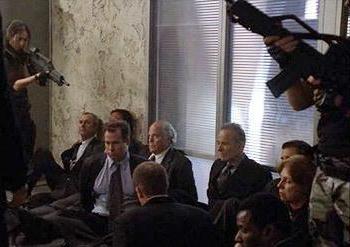In the modern world, the fight against terrorist attacks is carried out with the close cooperation of the special services of different countries. To some extent, terrorist activities include hostage taking. Art. 206 of the Criminal Code fixes the punishment for this act. Consider the norm in more detail. 
Art. 206 of the Criminal Code:
The capture / retention of a citizen as a hostage, committed to force the state, person, organization to perform a certain action or to refrain from it in exchange for the release of the detained subject, is punishable by 5-10 years in prison.
Sanction for an offense under Art. 206 of the Criminal Code in part 1, toughened if it is committed:
- By several citizens who agreed in advance on joint unlawful actions.
- With the use of violence dangerous to the victim.
- Using weapons / objects imitating it.
- In relation to a minor (if the perpetrator is aware of this).
- In relation to a pregnant woman (if the offender is aware of her condition).
- In relation to 2 or more citizens.
- For hire or from selfish motives.
In these cases, the perpetrator is sentenced to 6-15 years in prison. Additionally, according to part 2 Art. 206 of the Criminal Code, he is charged with 1-2 years of restraint of liberty.
Aggravating circumstances
3 parts Art. 206 of the Criminal Code, for hostage-taking organized group as well as resulting in the death of the victim through negligence, provides for 8-20 years in prison with 1-2 years of restraint of liberty. 
If the acts specified in parts 1, 2 were associated with deliberate infliction of death, the perpetrator faces 15-20 years of imprisonment with its restriction for 1-2 years or life imprisonment.
Punishable condition
According to the note to Art. 206 of the Criminal Codewho is guilty at the request of the authorities or voluntarily released a captured and held citizen, may be released from liability. Moreover, in his behavior there should be no signs of other crimes.
Explanations
Crime indicated in disposition Art. 206 of the Criminal Code, has an international character. Counteraction to such acts is carried out on the basis of the provisions of the Convention adopted by the UN General Assembly in 1979.
The specified normative act sets out the key areas of struggle against the seizure and retention of citizens. The document reveals the signs of the act established Art. 206 of the Criminal Code.
Capture is a physical restriction on a person’s ability to move freely. In this case, the victim becomes dependent on the invader. An attacker can use various methods to deter a victim, including death threats.
The purpose of the act is, as a rule, a ransom. 
Features of the Commission
Citizen capture qualifies according to Art. 206 of the Criminal Code when the actions of the perpetrator of unlawfulness are identified, when he uses violence to keep the subject. An act may be committed openly or secretly. An attacker can trick a victim into deception.
The nature of the requirements in assessing the criminality of actions does not matter. Moreover, they may be illegal and quite legitimate.
Detention implies forcible obstruction of the free movement of the victim, the exclusion of access to him by representatives of the authorities. The hostage may be kept in a room, which it is not possible to leave independently.
Goal specifics
The seizure is aimed at meeting the requirements, the fulfillment of which in a lawful way for the perpetrator is not possible.Their implementation acts as a prerequisite for the release of the retained person. 
Requirements may be political, nationalist, criminal, religious and other. For example, an invader may demand the release of a certain subject from prison, provide the named amount of money, ensure unhindered departure from the country, or not take any action.
Design features
The taking of a citizen hostage belongs to the category of continuing acts. The composition is formal. An infringement is deemed completed at the moment of direct restriction of the victim’s freedom, and if the guilty person holds the already captured victim, then from the moment of such detention, regardless of its duration.
If, for some reason, the seizure could not be completed, the act is regarded as an attempt on a crime.
Subjective aspect
The commission of a crime is characterized by direct intent. An attacker understands that he unlawfully restricts another person’s freedom, illegally holding him to force the authorities, organization or other citizen to satisfy his requirements. At the same time, the perpetrator wishes to commit these actions.
A 14-year-old sane citizen may be held liable.
Important point
In the event of the death of the victim or the occurrence of other serious consequences, if there are grounds for the actions of the perpetrator, they are characterized by guilt in two forms: direct intent and negligence. In the latter case, frivolity or carelessness in the behavior of the person is assumed. 
Signs of violence
Violence is recognized by qualifying circumstances. They can be expressed in:
- Deliberate infliction of bodily harm of varying severity.
- Torture.
- Other actions related to causing real damage to the health of the victim.
Use of weapons
This qualifying attribute should be evaluated in accordance with the provisions of the Federal Law No. 150.
In Art. 206 of the Criminal Code, we are talking about all types of weapons and items specified in this Federal Law and not mentioned in it. The subject can be any object brought in advance or selected at the crime scene. An important condition for its classification as a weapon is fitness for use in appropriate quality.
Capture of a minor or pregnant woman
The qualifying signs specified in clauses d and e of the analyzed norm can be applied if the guilty person knows that the citizen is under 18 years old and the woman is in an appropriate state. In this case, the gestational age does not matter. 
Condition of exemption from punishment
Note to article 206 secures the possibility of exclusion of liability for the perpetrator of the capture or retention of a person. If the subject committed another crime during this act, he shall be punished on a general basis. For example, the perpetrator illegally seized service (service) weapons, deliberately caused harm to the health of the detained person, destroyed or damaged property, etc.
The encouraging norm contained in the note aims to prevent or reduce the likelihood of more serious consequences. The motives on which a person refuses to continue the crime do not matter.